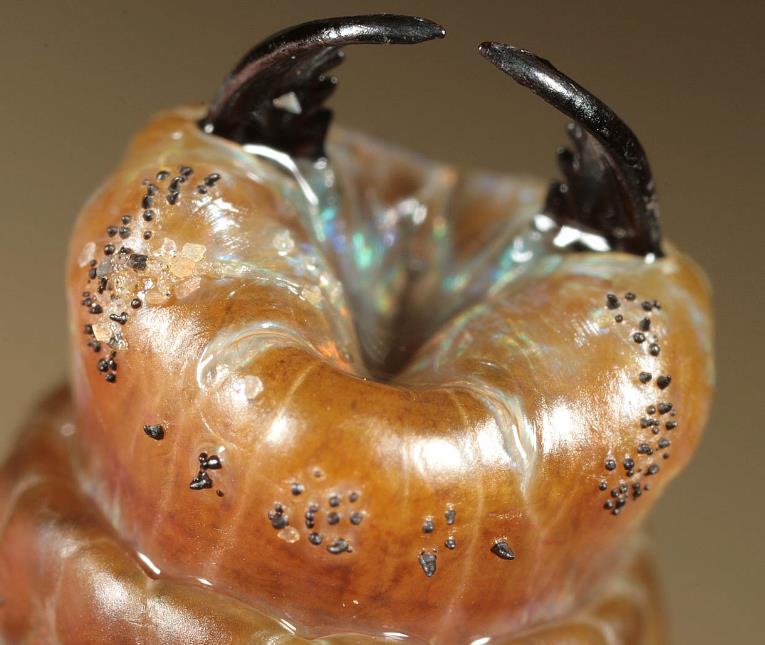Scientists have discovered fossils of a new species of giant predatory worms that ruled the seas more than 500 million years ago. The worms, named Timorebestia koprii, were about a foot long and had huge jaw structures in their mouths. They belonged to a group of marine animals called chaetognaths, or arrow worms, which are still alive today but much smaller and less fearsome.
The fossils of Timorebestia were found in Peary Land, the northernmost part of Greenland, by a team of paleontologists from the University of Bristol, the Natural History Museum of Denmark, and the Korea Polar Research Institute. The team was exploring the Sirius Passet fossil locality, which is one of the oldest and richest fossil sites in the world. The site dates back to the Early Cambrian period, when life on Earth exploded in diversity and complexity.

The team collected 13 specimens of Timorebestia, some of which had traces of their prey still in their stomachs or mouths. The fossils were exceptionally well-preserved, allowing the researchers to study the details of the worms’ anatomy, such as their fins, antennae, muscles, and nervous system. The researchers used a technique called electron probe microanalysis (EPMA) to map the carbon signatures in the fossils and create high-resolution images of the worms.
Why the Worms Were Called ‘Terror Beasts’
The researchers named the worms Timorebestia, which means ‘terror beasts’ in Latin, because of their large size and predatory nature. Timorebestia was one of the largest animals in the Early Cambrian oceans, and probably the top predator of its time. It fed on arthropods, which are invertebrates with hard exoskeletons, such as trilobites, crustaceans, and insects. Timorebestia had powerful jaws that could crush the shells of its prey and swallow them whole.
Timorebestia was also a fast and agile swimmer, thanks to its long and slender body and rows of fins along its sides. It had long antennae that helped it sense its surroundings and locate its prey. It also had a unique structure in its midsection that was part of its nervous system and helped it coordinate its movements. Timorebestia was a highly specialized and successful predator that dominated the oceans for about 10 to 15 million years.
How the Worms Are Related to Modern Arrow Worms
Timorebestia is a member of the phylum Chaetognatha, which includes about 150 species of arrow worms that live in the oceans today. Arrow worms are small, transparent, and worm-like animals that have a pair of hooks and teeth at the front of their bodies. They use these hooks and teeth to catch and eat plankton and small fish. Arrow worms are considered to be strongly carnivorous and voracious feeders.
The researchers found that Timorebestia shared some features with modern arrow worms, such as the presence of a mid-gut diverticulum, which is a pouch-like structure that extends from the digestive tract. This structure is unique to chaetognaths and helps them store and digest their food. However, Timorebestia also had some differences from modern arrow worms, such as the absence of spines or bristles on its body and the presence of large jaws instead of hooks and teeth. These differences suggest that Timorebestia was an early branch of the chaetognath family tree that evolved independently from the modern arrow worms.
What the Discovery Means for the History of Life
The discovery of Timorebestia sheds new light on the evolution and diversity of life in the Early Cambrian period. The Early Cambrian was a crucial time in the history of life, when many major groups of animals first appeared and diversified. The Sirius Passet fossil locality in Greenland is one of the few places in the world that preserves fossils from this period, and has revealed many bizarre and wonderful creatures, such as the five-eyed Opabinia and the spiny Anomalocaris.
The discovery of Timorebestia also shows that chaetognaths, or arrow worms, are one of the oldest and most successful groups of animals on Earth. They have survived for more than 500 million years and have adapted to different environments and lifestyles. They are also important components of the marine food web, as both predators and prey. The researchers hope that Timorebestia and other fossils from Greenland will help them better understand the origin and evolution of all the oceanic ecosystems.
